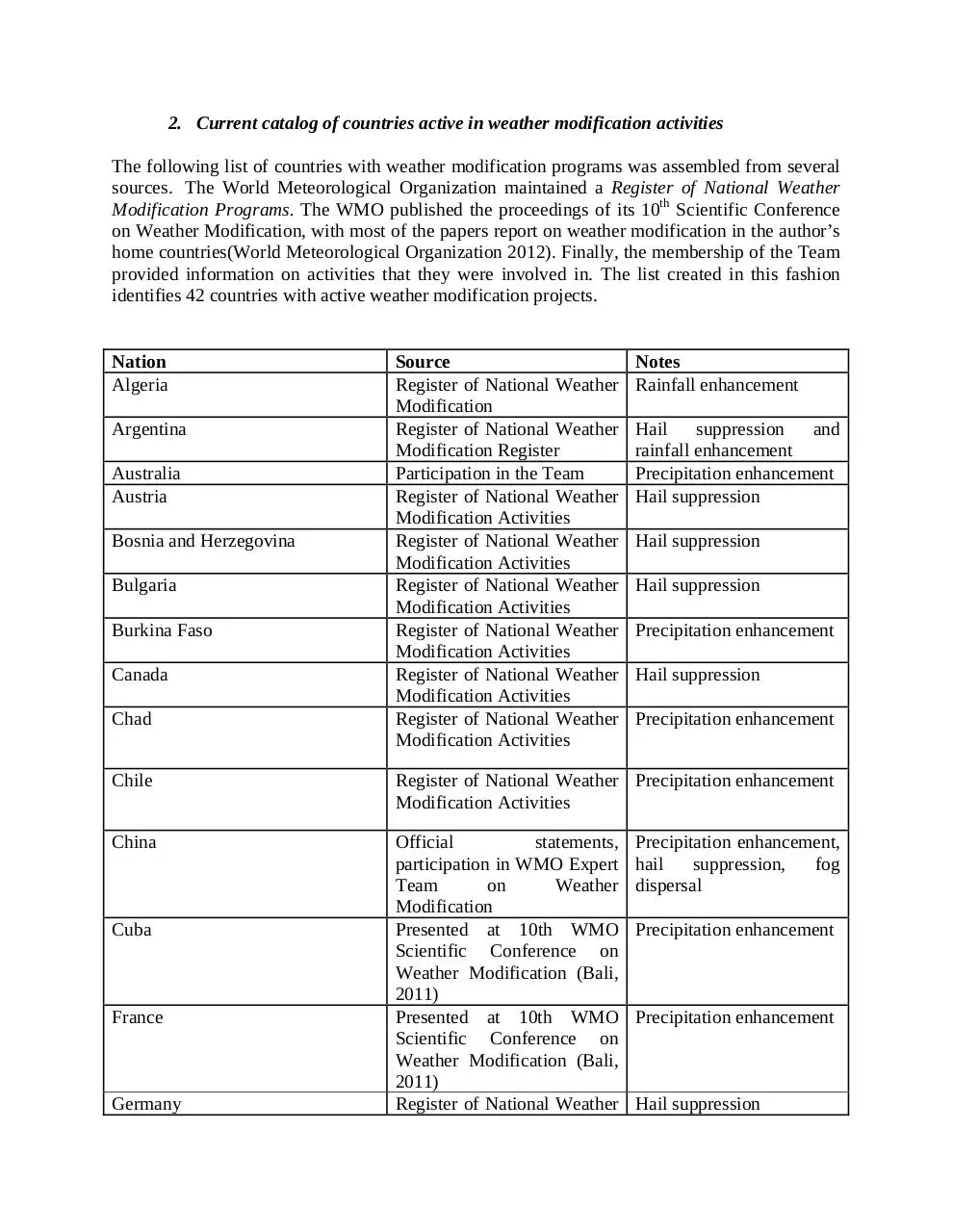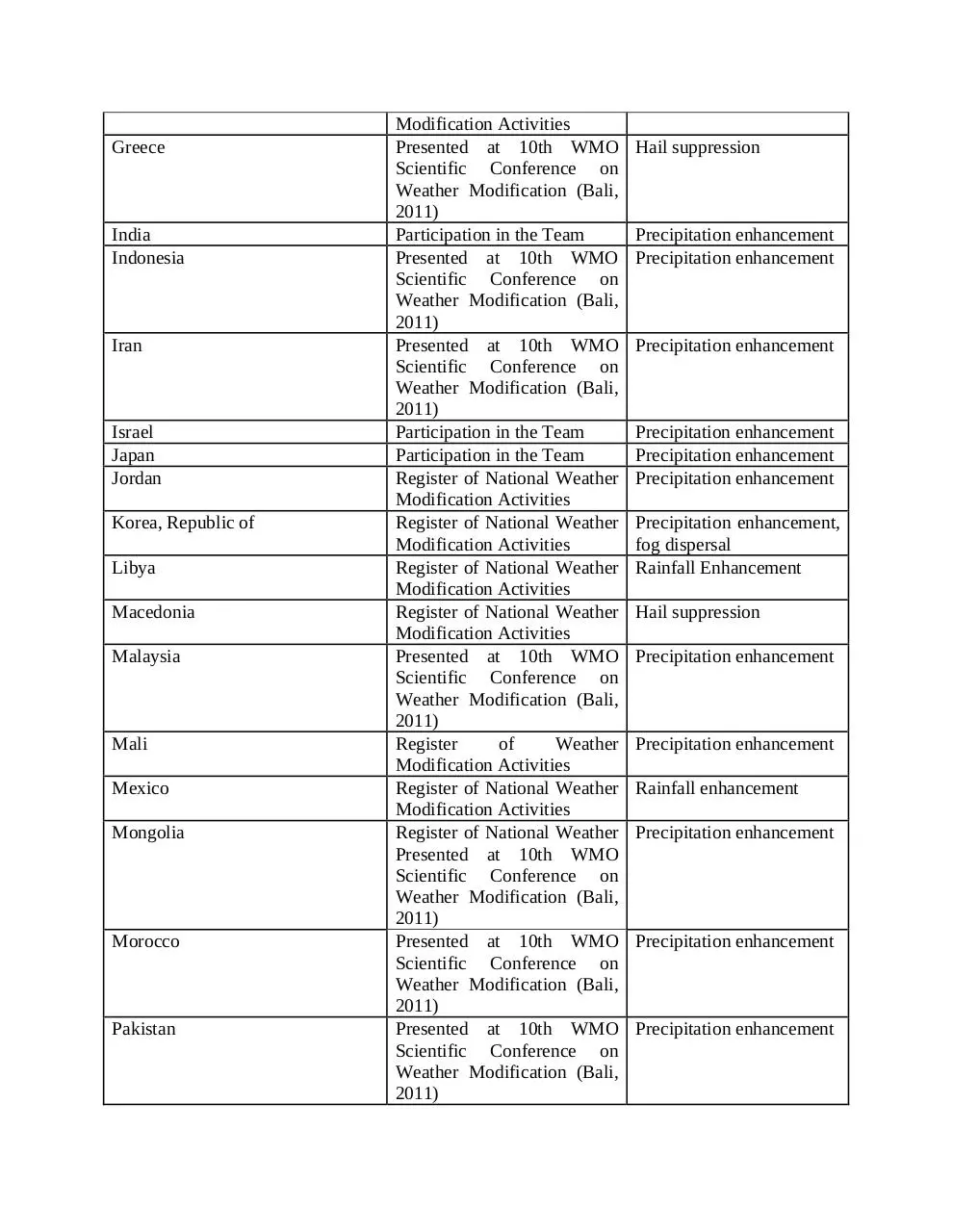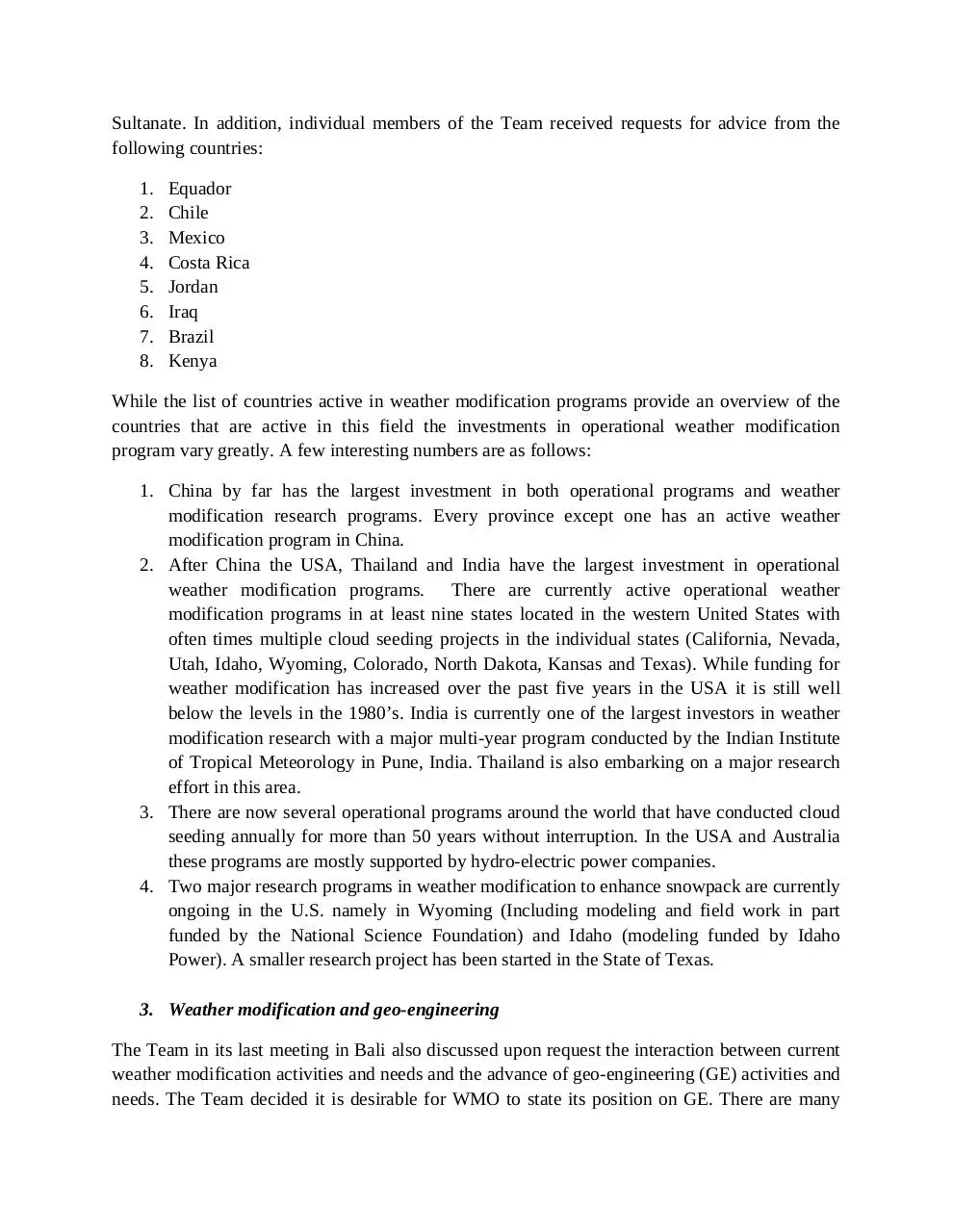Doc 3 6 weather mod 2013 Final tn (PDF)
File information
Title: Microsoft Word - Doc_3_6_weather_mod_2013_Final_tn.docx
Author: NTournier
This PDF 1.4 document has been generated by PScript5.dll Version 5.2 / Acrobat Distiller 8.2.0 (Windows), and has been sent on pdf-archive.com on 02/01/2016 at 14:42, from IP address 82.132.x.x.
The current document download page has been viewed 680 times.
File size: 669.3 KB (13 pages).
Privacy: public file





File preview
WORLD METEOROLOGICAL ORGANIZATION
COMMISSION FOR ATMOSPHERIC SCIENCES
(CAS)
6th Joint Science Committee of the World
Weather Research Programme
WMO
CAS/WWRP/JSC6/Doc 3.6
(xx June 2013)
Item: 3.6
Geneva, Switzerland (18-19 July 2013)
REPORT FROM EXPERT TEAM ON WEATHER MODIFICATION RESEARCH FOR
2012/2013
Roelof T Bruintjes (Chairman)
1. Introduction
This report provides an overview of the work of the Team since the International Weather
Modification Conference in Bali, Indonesia in 2011 and plans for the future. The current list of
members of the Expert Team on Weather Modification (hereafter the Team) is attached as
Appendix A.
Since 2010 the Expert Team has been dependent on a WMO Trust Fund to support its activities.
A request was sent to the Permanent Representatives of the WMO countries to request them to
contribute to the fund. The reaction to this request has been extremely limited. Considering that
weather modification activities in most countries are conducted outside the auspices of the
Meteorological Services in separate government departments it is not surprising that very little
response was received form the Permanent Representatives of members of WMO. This may call
for a different approach to obtain funding for the Trust Fund supporting the Team work by
directly identifying the entities that are involved in weather modification activities and then
approaching them through the PR’s.
Many countries are still using the WMO statements on weather modification including the
guidelines. The Team is planning its next meeting in Beijing, China in October 2013 coinciding
with the Course on Weather Modification that is sponsored by WMO and the Chinese
Meteorological Administration (CMA). CMA will also sponsor the committee meeting and cover
some of the associated travel costs.
2. Current catalog of countries active in weather modification activities
The following list of countries with weather modification programs was assembled from several
sources. The World Meteorological Organization maintained a Register of National Weather
Modification Programs. The WMO published the proceedings of its 10th Scientific Conference
on Weather Modification, with most of the papers report on weather modification in the author’s
home countries(World Meteorological Organization 2012). Finally, the membership of the Team
provided information on activities that they were involved in. The list created in this fashion
identifies 42 countries with active weather modification projects.
Nation
Algeria
Argentina
Australia
Austria
Bosnia and Herzegovina
Bulgaria
Burkina Faso
Canada
Chad
Source
Register of National Weather
Modification
Register of National Weather
Modification Register
Participation in the Team
Register of National Weather
Modification Activities
Register of National Weather
Modification Activities
Register of National Weather
Modification Activities
Register of National Weather
Modification Activities
Register of National Weather
Modification Activities
Register of National Weather
Modification Activities
Notes
Rainfall enhancement
Hail
suppression
and
rainfall enhancement
Precipitation enhancement
Hail suppression
Hail suppression
Hail suppression
Precipitation enhancement
Hail suppression
Precipitation enhancement
Chile
Register of National Weather Precipitation enhancement
Modification Activities
China
Official
statements,
participation in WMO Expert
Team
on
Weather
Modification
Presented at 10th WMO
Scientific Conference on
Weather Modification (Bali,
2011)
Presented at 10th WMO
Scientific Conference on
Weather Modification (Bali,
2011)
Register of National Weather
Cuba
France
Germany
Precipitation enhancement,
hail
suppression,
fog
dispersal
Precipitation enhancement
Precipitation enhancement
Hail suppression
Greece
India
Indonesia
Iran
Israel
Japan
Jordan
Korea, Republic of
Libya
Macedonia
Malaysia
Mali
Mexico
Mongolia
Morocco
Pakistan
Modification Activities
Presented at 10th WMO
Scientific Conference on
Weather Modification (Bali,
2011)
Participation in the Team
Presented at 10th WMO
Scientific Conference on
Weather Modification (Bali,
2011)
Presented at 10th WMO
Scientific Conference on
Weather Modification (Bali,
2011)
Participation in the Team
Participation in the Team
Register of National Weather
Modification Activities
Register of National Weather
Modification Activities
Register of National Weather
Modification Activities
Register of National Weather
Modification Activities
Presented at 10th WMO
Scientific Conference on
Weather Modification (Bali,
2011)
Register
of
Weather
Modification Activities
Register of National Weather
Modification Activities
Register of National Weather
Presented at 10th WMO
Scientific Conference on
Weather Modification (Bali,
2011)
Presented at 10th WMO
Scientific Conference on
Weather Modification (Bali,
2011)
Presented at 10th WMO
Scientific Conference on
Weather Modification (Bali,
2011)
Hail suppression
Precipitation enhancement
Precipitation enhancement
Precipitation enhancement
Precipitation enhancement
Precipitation enhancement
Precipitation enhancement
Precipitation enhancement,
fog dispersal
Rainfall Enhancement
Hail suppression
Precipitation enhancement
Precipitation enhancement
Rainfall enhancement
Precipitation enhancement
Precipitation enhancement
Precipitation enhancement
Philippines
Romania
Russian Federation
Saudi Arabia
Senegal
Serbia
South Africa
Syria
Spain
Thailand
United Arab Emirates
Uzbekistan
Zimbabwe
Register
of
Weather
Modification Activities
Register of National Weather
Modification Activities
Register of National Weather
Modification Activities
Precipitation enhancement
Register
of
Weather
Modification Activities
Register of National Weather
Modification Activities
Register of National Weather
Modification Activities
Precipitation enhancement
Hail suppression
Precipitation enhancement,
hail
suppression,
fog
dispersal,
precipitation
redistribution, protection
from snow avalanches
Presented at 10th WMO Precipitation enhancement
Scientific Conference on
Weather Modification (Bali,
2011)
Presented at 10th WMO Precipitation enhancement
Scientific Conference on
Weather Modification (Bali,
2011)
Presented at 10th WMO Hail suppression
Scientific Conference on
Weather Modification (Bali,
2011)
Presented at 10th WMO Precipitation enhancement
Scientific Conference on
Weather Modification (Bali,
2011)
Register of National Weather Precipitation enhancement
Modification Activities
Register of National Weather Hail suppression
Modification Activities
Participation in the Team
Precipitation enhancement
Precipitation enhancement,
hail suppression
Rainfall enhancement
Since the International Weather Modification Conference in 2011 the WMO and the Team have
been approached by two countries to provide advice on weather modification programs namely,
Burkina Faso and Qatar. In addition, in December 2011, the Sultanate of Oman organized a
workshop in Muscat to investigate the feasibility of a weather modification program in the
Sultanate. In addition, individual members of the Team received requests for advice from the
following countries:
1.
2.
3.
4.
5.
6.
7.
8.
Equador
Chile
Mexico
Costa Rica
Jordan
Iraq
Brazil
Kenya
While the list of countries active in weather modification programs provide an overview of the
countries that are active in this field the investments in operational weather modification
program vary greatly. A few interesting numbers are as follows:
1. China by far has the largest investment in both operational programs and weather
modification research programs. Every province except one has an active weather
modification program in China.
2. After China the USA, Thailand and India have the largest investment in operational
weather modification programs. There are currently active operational weather
modification programs in at least nine states located in the western United States with
often times multiple cloud seeding projects in the individual states (California, Nevada,
Utah, Idaho, Wyoming, Colorado, North Dakota, Kansas and Texas). While funding for
weather modification has increased over the past five years in the USA it is still well
below the levels in the 1980’s. India is currently one of the largest investors in weather
modification research with a major multi-year program conducted by the Indian Institute
of Tropical Meteorology in Pune, India. Thailand is also embarking on a major research
effort in this area.
3. There are now several operational programs around the world that have conducted cloud
seeding annually for more than 50 years without interruption. In the USA and Australia
these programs are mostly supported by hydro-electric power companies.
4. Two major research programs in weather modification to enhance snowpack are currently
ongoing in the U.S. namely in Wyoming (Including modeling and field work in part
funded by the National Science Foundation) and Idaho (modeling funded by Idaho
Power). A smaller research project has been started in the State of Texas.
3. Weather modification and geo-engineering
The Team in its last meeting in Bali also discussed upon request the interaction between current
weather modification activities and needs and the advance of geo-engineering (GE) activities and
needs. The Team decided it is desirable for WMO to state its position on GE. There are many
aspects common to both GE and WM but at different spatial scales. It was also stated that if we
still do not understand WM at small scales, understanding what the impacts of GE would be at
large/global scale, should be seen as a major challenge. It was also decided that a statement on
GE should not be a part of WMR statement and GE in its totality should not be considered as
part of the mandate of the ET-WMR because there are several aspects that do not relate to clouds
in GE that falls outside the scope of expertise of the committee. Recently, the International
Commission on Cloud Physics (ICCP) of IAMAS released a draft statement on Radiation
Management
Climate
Engineering
(http://www.iccpiamas.org/pdf/ICCP_RadiationManagement_Statement_Jan14_V4_2013.pdf).
This draft
statement (Appendix B) highlights some of the challenges related to GE. While GE studies to
date have primarily focused on desktop and modeling studies and no field work have been
conducted as opposed to weather modification activities to enhance precipitation and mitigate
severe weather that have both modeling and field data support. Increasing our understanding of
the effects of cloud seeding on local and regional scales will also contribute to the understanding
of GE principles (NAS, 2003). Many of the National Academy of Sciences report in 2003 have
still not been implemented to date.
4. Recent scientific achievements
In this section we highlight a few recent achievements in the field of weather modification
research. In an editorial column in Nature it was stated that “…weather modification is one of
those areas in which science can have an immediate and obvious benefit for society” (Nature
2008). During the past ten years with the advent of a new set of remote sensors and more
sophisticated airborne instrumentation in addition to more advanced numerical modeling
capabilities new opportunities were provided to assess and quantify the results from cloud
seeding experiments. Two major cloud seeding research projects have utilized some of these new
capabilities recently.
The first was the Wyoming Weather Modification Pilot Project (WWMPP) sponsored by the
State of Wyoming (Breed et al., 2013) with participation of the University Wyoming and the
National Center for Atmospheric Research (NCAR). This program had a major observational
component (Breed et al, 2013; Geerts et al., 2010), a numerical modeling component (Breed et
al., 2013; Xue et al., 2013a and 2013b) and a randomized cloud seeding experiment that started
in 2006 and will be completed in 2014. Although the statistical results from the randomized
experiment is not yet available because the experiment is still ongoing, Geerts et al. (2010)
provided for the first time experimental evidence using vertically pointing airborne radar data
that ground-based silver iodide seeding can increase reflectivity in the PBL in orographic snow
producing storms over complex terrain. Although the results have limitations based on the small
sample size and natural variability they showed that the observed enhancement of high
reflectivity values (>10 dBz)in the PBL has a 2.2% probability of being chance with a 97.8%
certainty that the increased probability of higher snowfall rates during seeding is not by chance.
These results provide strong observational support for the results from recent randomized
statistical experiments in other parts of the world (Manton et al., 2011 and Manton and Warren,
2011). One of the major impediments in many previous statistical experiments in mountainous
regions is the accurate targeting of appropriate supercooled cloud regions especially in groundbased cloud seeding experiments (Breed et al., 2013).
Another major achievement in the field of winter orographic cloud seeding is the use of
numerical models such as the NCAR-WRF model to help design, guide and evaluate cloud
seeding efforts to enhance snowpack in mountainous terrain. (Breed et al., 2013; Xue et al.,
2013a and 2013b). In addition, a silver iodide cloud seeding parameterization has been recently
implemented in the WRF model (Xue et al. 2013a and 2013b; Fig. 1). The seeding rates can be
varied and two scenarios of seeding are possible (ground based and airborne). These studies
provide a new opportunity to better design, guide and evaluate winter orographic cloud seeding
experiments.
Figure 1: Implementation of a silver iodide cloud seeding module in the WRF
Model.
The second major cloud seeding research projects concerning summertime convective clouds
were recently conducted in Queensland, Australia (Tessendorf et al., 2012 and Tessendorf et al.,
2013) and in in India by the Indian Institute of Tropical Meteorology (IITM) (Kulkarni et al.,
2012; Konwar et al., 2012; and Prabha et al., 2011). Both these projects highlighted the
importance of natural variability that can mask the results form randomized cloud seeding
programs. One of the major challenges still remains the large natural variability that can occur in
both time and space even in one region. Both projects have shown that with new remote sensing
tools this variability should be taken into account when conducting cloud seeding research
programs.
In addition, in the Queensland project the use of dual polarization radar data provided new
insights into the evolution of precipitation in clean (maritime) and more polluted (continental)
environments. The initial evolutions of the rain drop size distributions were found to be different
in maritime and continental clouds (Fig. 2). This has impacts on cloud seeding experiments
because differences in rain drop size distributions if affected by seeding may influence the
reflectivity especially when radar is used to assess cloud seeding effects.
Figure 2: Comparison of a) RICO and b) Queensland plots of AZh versus AZdr . The data are for
all radar elevation angles above 0.5 deg. The red points represent growing phase (AZh
increasing) and the blue points represent AZh either constant or decreasing. The RICO data
represent 190 clouds and the Queensland data 30 clouds. Each plot shows two reference curves
the left represents the standard Marshall-Palmer rain drop size distribution and the right
represents one drop per cubic centimeter of the size that produces the corresponding Zh value.
Finally, many summertime convective cloud seeding experiments now use hygroscopic flares to
enhance the condensation-coalescence process. Bruintjes et al. (2012) conducted a study to better
characterize the particle spectra from these flares in order to be able to better assess the impacts
of this seeding method.
5. Conclusions and future work
Based on the previous paragraphs it is clear that weather modification activities are still
abounding around the world and several major research programs in this field have been initiated
in the past few years which in my view emphasize the legitimacy and need for the Team.
Although the contributions to the WMO trust fund for this activity have been very limited this is
to some extent to be expected for reasons mentioned earlier. In the meantime the Team has been
working with the CMA and their course on weather modification and hope to convene its next
meeting to coincide with the course so that members can also give presentations at the course.
The meeting will be sponsored by the CMA.
The immediate plans for the work of the Team are as follows:
a. Convene the next meeting of the Team in conjunction with the CMA course on Weather
Modification in Beijing, China in October 2013.
b. Adapt the approach to solicit contributions for the work of the Team by including the
agencies and private industry in countries that are active in the field of weather
modification.
c. Draft a recommendation on how to address geo-engineering aspects
6. References
Bruintjes, R.T. Vidal Salazar, T. A. Semeniuk, P. Buseck, D. W. Breed and Jim Gunkelman,
2012: Design and performance of a hygroscopic flare cloud seeding test facility. Journal of
Weather Modification, 44, 69-94.
Breed, D., R. Rasmussen, B. Lawrence, B, Boe, T. Deshler, and C. Weeks, 2013: Evaluating
winter orographic cloud seeding: Design of the Wyoming Weather Modification Pilot Project
(WWMPP). Accepted for publication in J. Appl. Meteor. Climatology.
Geerts, B., Q. Miao, Y. Yang, R. Rasmussen, and D. Breed, 2010: The impact of glaciogenic
cloud seeding on snowfall from winter orographic clouds, J. Atmos. Sci., 67, 3286 – 3302.
Geerts, B., B. Pokharel, K. Friedrich, D. Breed, R. Rasmussen, Y. Yang, Q. Miao, S. Haimov , B.
Boe, E. Kalina, and B. Lawrence, 2013: The AgI Seeding Cloud Impact Investigation (ASCII)
campaign 2012: overview and preliminary results. J. Wea. Modif., 45, (accepted for publication).
Konwar M., Maheskumar R.S., Kulkarni J.R., Freud E., Goswami B.N., Rosenfeld D., Aerosol
control on depth of warm rain in convective clouds, Journal of Geophysical Research, , 117, July
2012, D13204, DOI:10.1029/2012JD01785, 1-10.
Kulkarni J.R., Maheshkumar R.S., Morwal S.B., Padma kumari B., Konwar M., Deshpande
C.G., Joshi R.R., Bhalwankar R.V., Pandithurai G., Safai P.D., Narkhedkar S.G., Dani K.K.,
Nath A., Nair Sathy, Sapre V.V., Puranik P.V., Kandalgaonkar S.S., Mujumdar V.R., Khaladkar
R.M., Vijaykumar R., Prabha T.V., Goswami B.N., The Cloud Aerosol Interaction and
Precipitation Enhancement Experiment (CAIPEEX): overview and preliminary results (2012),
Curr. Sci., Vol.102, 2012, 413-425
Manton, M. J., Warren, L., Kenyon, S. L., Peace, A. D., Bilish, S. P., and Kemsley, K., 2011: A
confirmatory snowfall enhancement project in the Snowy Mountains of Australia. Part I: Project
design and response variables. Jour. of Appl. Meteor. and Climat., 50, 1432-1447.
Manton, M. J., Warren, L., 2011: A confirmatory snowfall enhancement project in the Snowy
Mountains of Australia. Part II: Primary and associated analyses. Jour. of Appl. Meteor. and
Climat., 50, 1448-1458.
Nature, 2008: Change in the weather. Nature, 453, 957958.
Download Doc 3 6 weather mod 2013 Final tn
Doc_3_6_weather_mod_2013_Final_tn.pdf (PDF, 669.3 KB)
Download PDF
Share this file on social networks
Link to this page
Permanent link
Use the permanent link to the download page to share your document on Facebook, Twitter, LinkedIn, or directly with a contact by e-Mail, Messenger, Whatsapp, Line..
Short link
Use the short link to share your document on Twitter or by text message (SMS)
HTML Code
Copy the following HTML code to share your document on a Website or Blog
QR Code to this page

This file has been shared publicly by a user of PDF Archive.
Document ID: 0000328908.